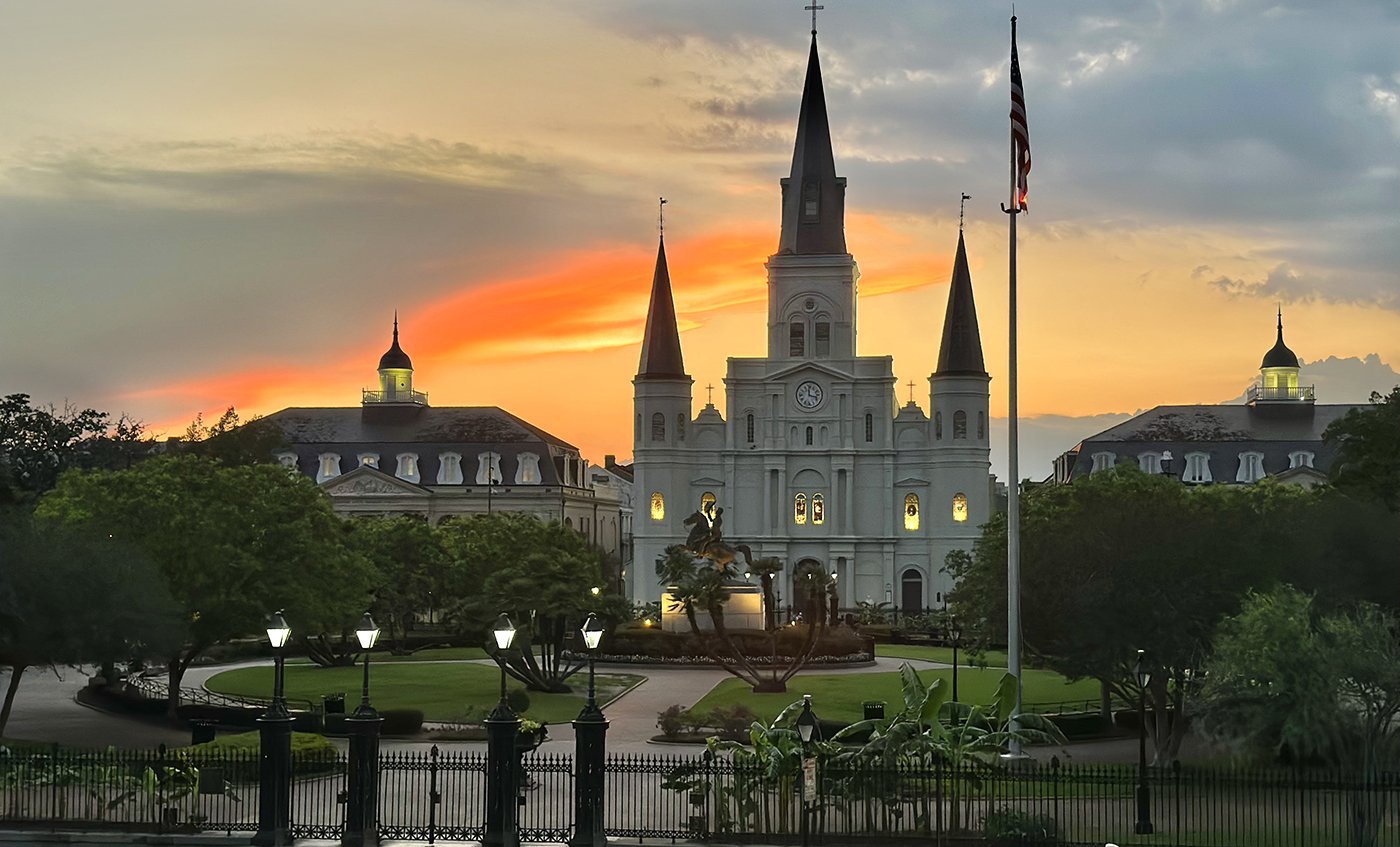Return to New Orleans
Sunset on Jackson Square. Photos in this essay by Ellis Anderson for French Quarter Journal
After living in New Orleans for more than a decade, a writer who has moved away gets “all funny” when he returns to visit.
-by Richard Goodman
Sometimes the way you learn about a city is by leaving it.
I lived in New Orleans for eleven years, from 2011 to 2022. I began my stay in the French Quarter. I lived for a year on Ursulines Avenue in a furnished apartment on the ground floor that faced the street. A year later, looking for a larger space—I couldn’t afford that in the Quarter—I moved to the Marigny, where I lived for the next ten years.
I left New Orleans in June 2022. Since then, I’ve been back five or six times. Each time I return, I learn more about what those eleven years meant. Distance provides clarity—at least for me.
When I was living in New Orleans, I didn’t write much about it. I wrote a few pieces for the French Quarter Journal, one about living in the French Quarter, and one about Tennessee Williams and the Quarter. But, mostly, I was stymied, held myself back, by what I saw as an extremely proprietary sense about the city.
I heard this said again and again about people who wrote about the city, “They just don’t get New Orleans.” It seemed that only a few people did, and those people were heavily steeped in its history and culture. So I was intimidated.
The writer Rich Cohen wrote that New Orleans can seem “like two towns—the one seen by the drunken conventioneer…the other seen by the native, secret and protected.” Indeed, that’s the way I often felt as a writer, that the city’s spirit is secret and protected.
The path to a French Quarter courtyard on Chartres Street
Now I realize I shouldn’t have been so intimidated. I’m not trying to define New Orleans. I’m just trying to write what I know and learned about the city. Well, even what that is I’m not entirely sure, but at least I’m not claiming my experience is true for everybody.
I may never get New Orleans, according to those who decree these things. I’ll leave that to others to try. I have my own New Orleans. The way I see it, and how it resides in me.
How is that? I came to believe that New Orleans sees itself as a separate country. It really doesn’t care about the rest of the United States. I think it should have its own flag and its own money, its own stamps and passport. Its own ambassador. It’s perfectly content to be sui generis, one of a kind, separate from everyone. It shrugs its shoulders at the outside world, if it thinks about the outside world at all. It finds itself enough.
It’s a city whose foundations weren’t solely built on commerce but, notably and evidently, on art. Commerce is in its past and its present, to be sure, but the city’s guiding spirit is not money, but music. And artistic individuality. Not to mention a mélange of cultures and peoples.
One ready indication: New York’s airports, La Guardia and Kennedy, are named after politicians. New Orleans’ airport is named after a musician, Louis Armstrong, and one of America’s true geniuses at that. The city knows who it wants the world to be greeted by, knows who embodies the soul of the place. I always feel a sense of pride when I fly into this airport.
New Orleans is also one of the strangest cities I have ever been to, much less lived in. And most unlikely.
The 2023 World Naked Bike Ride to raise awareness for bike safety featured around 400 riders cycling through the French Quarter.
The late novelist Robert Stone, who lived in New Orleans for a year when he was young and whose first book, “A Hall of Mirrors,” was written, and is set, in New Orleans, said, “I go all funny when I get to New Orleans.”
That’s what happened to me when I drove into the city the other day and down leafy Carrollton Avenue, coming back after a hiatus. I got all funny. My heart beat faster. It only reminded me of how deep an impression New Orleans has left on me. I only understood the full extent of this mark it has bestowed on me by saying goodbye—and then returning. The city, after my severing of physical ties, essentialized, and when I came back, I saw, and felt, the unique splendor of it.
I can always turn to Tennessee Williams for an iconic pronouncement. He said, “America has only three cities: New York, San Francisco, and New Orleans. Everywhere else is Cleveland.” Poor Cleveland. It always ends up a punchline, doesn’t it? I agree with Tennessee, though.
I drove down Carrollton to City Park and then down Esplanade Avenue, my single favorite New Orleans street. It’s a street that seems to have been created by a French Impressionist, with thrilling, inventive changes of light and shadow, an endless canopy of live oaks, and a stately grace. It brings a kind of peace driving its length.
I drove past Rampart to where Esplanade becomes one of the four borders of the French Quarter. I parked my car and walked into the Quarter. It was a sunny day, not too hot. I walked down Royal Street, imbibing memories and also absorbing the clarity my absence provided. I saw ghosts. I heard voices from years ago. I encountered friends who were no longer there. I watched myself grow and stumble.
What emerged on that walk was a sense of pure gratitude. It only flourished as I walked back to my car. I was lucky to have lived in New Orleans. Most people never do.
A Royal Street balcony garden
Help support our creative team –become a member of our Readers’ Circle now!




